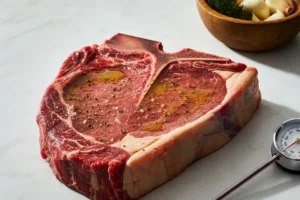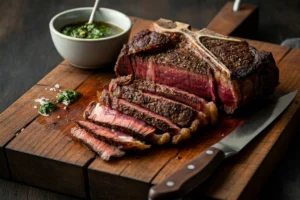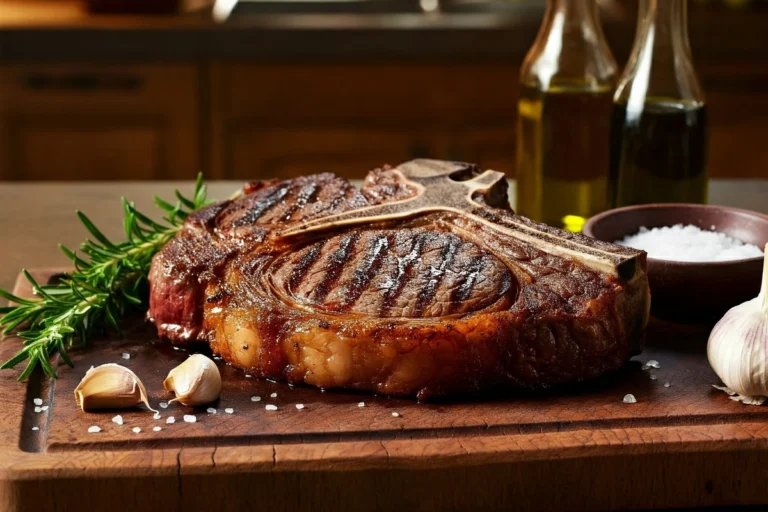Cooking a porterhouse steak can seem intimidating at first, but with the right knowledge and techniques, you can prepare this prized cut of beef to perfection. Whether you’re a seasoned chef or a grilling enthusiast, this guide covers everything you need to know—from choosing the perfect steak to achieving the ideal doneness and pairing it with complementary sides.
In this article, we’ll explore different cooking methods, seasoning tips, and the essential tools to help you master the art of how to cook a porterhouse steak. Plus, you’ll learn how to avoid common mistakes and elevate your dining experience. Let’s dive in!
Introduction to Cooking a Porterhouse Steak
What is a Porterhouse Steak?
A porterhouse steak is a king among cuts. It’s a bone-in steak that combines two delectable cuts of beef: the tenderloin and the strip steak. The tenderloin offers a buttery, melt-in-your-mouth texture, while the strip steak is rich and beefy. Together, they deliver a dining experience that’s hard to beat.
This cut comes from the rear section of the short loin, making it larger and more tender than the T-bone steak. The bone in the middle not only divides the two cuts but also enhances flavor during the cooking process.
Why is Porterhouse Steak Unique?
What sets the porterhouse steak apart is its size and versatility. Its dual cuts provide varying textures and flavors, making it a favorite for steak lovers. However, cooking it perfectly requires attention to detail. The tenderloin cooks faster than the strip side, so knowing how to manage heat is crucial.
Overview of Cooking Techniques for Porterhouse Steak
When it comes to cooking a porterhouse steak, there are several methods to choose from:
- Grilling: Ideal for smoky, charred flavors.
- Pan-searing: Perfect for a golden crust.
- Reverse searing: A foolproof way to get an even cook.
- Oven-baking: Great for larger cuts that need slower cooking.
Each method requires slightly different tools and steps, but all can yield restaurant-quality results when done right. With the basics in mind, you’re ready to move on to the next step: selecting the perfect porterhouse steak.
Choosing the Perfect Porterhouse Steak
Understanding Meat Grades
When selecting a porterhouse steak, the first thing to consider is the meat grade. In the U.S., beef is graded by the USDA based on tenderness, juiciness, and flavor. The three main grades are:
- Prime: The highest quality with abundant marbling. It’s perfect for how to cook a porterhouse steak to achieve exceptional flavor.
- Choice: A step below Prime, with less marbling but still excellent for grilling or pan-searing.
- Select: Leaner cuts with minimal marbling, requiring careful cooking to avoid dryness.
Selecting the Right Cut and Thickness
A well-marbled steak ensures both flavor and moisture during cooking. Look for even distribution of white fat throughout the meat. The thickness is just as important; a steak that’s 1.5 to 2 inches thick is ideal for even cooking, especially when using methods like reverse searing.
Where to Buy High-Quality Porterhouse Steak
You can find porterhouse steaks at:
- Local Butcher Shops: They often have fresher, higher-quality cuts than supermarkets.
- Online Retailers: Premium steak suppliers ship fresh or frozen cuts to your doorstep.
- Specialty Grocers: Stores like Whole Foods and Trader Joe’s offer well-sourced porterhouse steaks.
For an in-depth guide on steak anatomy, consider exploring this article about porterhouse steaks.
Preparing Your Porterhouse Steak
Proper Thawing Techniques
To maintain the steak’s integrity, thaw it slowly in the refrigerator for 24-48 hours. Avoid quick-thaw methods like microwaving, as they can cause uneven cooking.
Seasoning and Marinades for Maximum Flavor
The beauty of a porterhouse steak lies in its natural flavor, so you don’t need to overdo the seasoning. A simple blend of kosher salt, freshly cracked black pepper, and garlic powder works wonders. If you want extra depth, try a marinade using olive oil, minced garlic, rosemary, and soy sauce for at least 30 minutes.
Resting the Meat Before Cooking
Allow your steak to rest at room temperature for 30-45 minutes before cooking. This ensures even cooking, especially when preparing how to cook a porterhouse steak with methods like grilling or reverse searing. Resting also reduces the risk of cold spots in the center.

For more tips on achieving even cooking, check out this detailed guide on grilling porterhouse steaks.
Cooking Methods for Porterhouse Steak
Grilling Porterhouse Steak: Step-by-Step Instructions
Grilling is one of the best methods for cooking a porterhouse steak, as it creates that classic charred flavor. Here’s how to do it:
- Preheat the Grill: Heat your grill to medium-high, ensuring it reaches around 450°F.
- Prep the Steak: Lightly brush your steak with olive oil and season generously with kosher salt and black pepper.
- Sear on High Heat: Place the steak on the hottest part of the grill and sear for 2-3 minutes on each side to lock in the juices.
- Move to Indirect Heat: Shift the steak to a cooler part of the grill and close the lid. Cook until it reaches your desired doneness.
- Check Temperature: Use a meat thermometer to ensure accuracy. For medium-rare, aim for 130°F in the thickest part of the steak.
Pan-Searing for a Perfect Crust
Pan-searing is ideal for achieving a golden-brown crust on your porterhouse steak:
- Use a heavy skillet, like cast iron, and preheat it until it’s smoking hot.
- Add a splash of oil and carefully place the steak in the pan. Sear each side for about 3-4 minutes.
- For thicker steaks, finish them in a preheated oven at 400°F for 5-7 minutes.
Reverse Searing for Even Doneness
This method ensures an even cook, especially for thick cuts:
- Preheat your oven to 250°F and place the steak on a wire rack over a baking sheet.
- Cook slowly until the internal temperature reaches 120°F.
- Remove the steak and quickly sear it in a hot skillet or grill for 1-2 minutes per side.
Oven Cooking for a Classic Finish
If you don’t have access to a grill, the oven is a reliable alternative:
- Preheat the oven to 400°F.
- Sear the steak in a pan on the stovetop first, then transfer it to the oven.
- Cook for 6-10 minutes, depending on the thickness and desired doneness.
For more grilling techniques, check out this guide on porterhouse steak preparation.
Achieving the Perfect Doneness
Understanding Steak Temperature and Doneness Levels
Knowing how to cook a porterhouse steak to your preferred doneness is essential:
- Rare: 120-125°F, bright red center.
- Medium-Rare: 130-135°F, warm red center.
- Medium: 140-145°F, slightly pink center.
- Well-Done: 160°F and above, no pink center.
Using a Meat Thermometer for Accuracy
A meat thermometer is your best friend when aiming for precision. Insert it into the thickest part of the steak, avoiding the bone. Always check the temperature toward the end of cooking to prevent overcooking.
Adjusting Cook Times for Desired Doneness
Cooking times vary based on the thickness of the steak and cooking method:
- Grilling: Sear for 2-3 minutes per side, then cook indirectly for 4-7 minutes.
- Pan-Searing: Sear for 3-4 minutes per side and finish in the oven for 5-8 minutes.
- Reverse Searing: Bake for 30-40 minutes, then sear for 1-2 minutes per side.
For more delicious recipes and tips on perfecting steak cooking, check out other helpful articles at Goldy Recipe.
Resting and Slicing Your Porterhouse Steak
Why Resting is Essential After Cooking
Resting is a crucial step in how to cook a porterhouse steak. Once you’ve removed the steak from heat, let it rest for 5-10 minutes. This allows the juices, which are pushed to the center during cooking, to redistribute evenly throughout the meat. Skipping this step can result in dry slices and a less flavorful steak.
Resting also ensures that the steak’s internal temperature continues to rise slightly, completing the cooking process without drying out the meat. Cover the steak loosely with aluminum foil to retain warmth while it rests.
How to Properly Slice a Porterhouse Steak
Slicing your porterhouse steak correctly is just as important as cooking it. Start by separating the two main cuts—the tenderloin and the strip steak—using a sharp knife to cut along the bone.
Once separated, slice each section against the grain. This technique shortens the muscle fibers, making each bite tender and easy to chew. Cut into even slices about ½ inch thick for the best texture and presentation.
Serving Suggestions for Presentation
Plate your slices neatly, keeping the tenderloin and strip steak sections distinct. Arrange them around the bone for a visually striking display. Adding a sprinkle of flaky sea salt or a pat of herb butter before serving can enhance the flavors.

Pairing Your Porterhouse Steak
Choosing the Perfect Side Dishes
When considering how to cook a porterhouse steak, you’ll want sides that complement its robust flavors. Classic options include:
- Creamed Spinach: Rich and creamy, it balances the steak’s savory taste.
- Garlic Mashed Potatoes: A hearty side that pairs perfectly with juicy steak.
- Grilled Asparagus: Adds a crisp, earthy note to the meal.
Wine and Beverage Pairings
The bold flavors of a porterhouse steak pair beautifully with full-bodied red wines like Cabernet Sauvignon or Malbec. If you prefer beer, go for a dark stout or porter to match the steak’s richness. For non-alcoholic options, a sparkling water with lemon or iced tea can cleanse the palate.
Sauces to Complement Porterhouse Steak
While a well-cooked steak shines on its own, sauces can elevate the experience. Consider:
- Red Wine Reduction: Deep and tangy, perfect for bold flavors.
- Bearnaise Sauce: A creamy, herby option for added richness.
- Chimichurri: Fresh and zesty, it adds a bright contrast to the steak.
With these pairing tips, you can turn your steak dinner into a gourmet experience.
Common Mistakes to Avoid
Overcooking or Undercooking the Steak
One of the most frequent errors in how to cook a porterhouse steak is not hitting the right level of doneness. Overcooking leads to dry, tough meat, while undercooking can leave the center raw and unappetizing. Always use a meat thermometer to check the internal temperature, and remove the steak from heat when it’s a few degrees below your target temperature. Remember, the steak continues to cook slightly while resting.
Improper Use of Heat
Another common pitfall is using either too much or too little heat. High heat is essential for achieving a beautiful sear, but if it’s too intense, you risk burning the exterior before the interior cooks. Conversely, low heat can prevent proper caramelization, leaving the steak pale and underwhelming. A combination of high heat for searing and moderate heat for finishing is ideal.
Skipping the Resting Period
Skipping the resting period is a rookie mistake. Resting allows the juices to redistribute within the steak, ensuring every bite is juicy and flavorful. Cutting into the steak too soon can cause the juices to spill out onto the plate, leaving the meat dry.
Frequently Asked Questions
How Long Should I Cook a Porterhouse Steak?
Cooking time varies based on the steak’s thickness and your desired doneness. For a 1.5-inch-thick steak, aim for 3-4 minutes per side for medium-rare when grilling. Always rely on a meat thermometer for precise results.
What’s the Difference Between Porterhouse and T-Bone Steaks?
Both steaks come from the short loin and feature a T-shaped bone. The porterhouse has a larger tenderloin section compared to the T-bone, making it the more premium cut. This distinction is crucial when learning how to cook a porterhouse steak.
Can I Cook a Porterhouse Steak in an Air Fryer?
Yes! While unconventional, an air fryer can cook a porterhouse steak. Preheat to 400°F, season the steak, and cook for 8-12 minutes, flipping halfway through. Keep a close eye on the internal temperature to avoid overcooking.
Conclusion
Mastering how to cook a porterhouse steak is easier than you think when armed with the right knowledge and techniques. From selecting a high-quality cut to choosing the perfect cooking method and avoiding common mistakes, this guide has covered it all. By pairing your steak with complementary sides and beverages, you can create a meal that’s both satisfying and memorable.
Whether you’re grilling, pan-searing, or trying out a reverse sear, the key to success lies in attention to detail and a love for great food. Now that you’re equipped with these tips, it’s time to turn your kitchen into a steakhouse and impress your guests with a perfectly cooked porterhouse steak.

